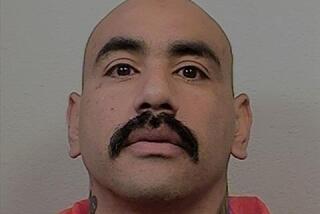As Drive-By Gang Killings Fall, ‘Walk-Up’ Attacks Rise
Drive-by gang shootings, one of Los Angeles’ most notorious legacies, are giving way to a more accurate form of murder: “up close and personal” homicides, in which a gun is fired at close range, law enforcement officials say.
This year’s estimated 20% decline in drive-bys in the county springs not from law enforcement efforts, but from a decree against such shootings issued by the Mexican Mafia crime syndicate three years ago, experts say.
The result: more people such as Jose Corrales, 20, of Boyle Heights, who was shot in his spine and arm by a rival gang member during a “walk-up” shooting.
Even Corrales appreciates the change as a matter of honor.
“If you are going to be a man and shoot somebody, at least have the [courage] to walk up to them,” he said. “It’s one thing to shoot at somebody from a car, it’s another to look them in the face and shoot them.”
The decline in drive-bys has not stemmed the number of gang homicides--they reached an all-time high in Los Angeles County of 807 last year.
But this newest trend in gang-related violence may lower the number of unintended victims wounded or killed in gang warfare.
“When you are driving by, you are not as accurate. You walk up, you have a higher kill ratio,” said Capt. Dan Koenig, commanding officer of the Los Angeles Police Department’s detective support division and an anti-gang coordinator.
According to one medical study, for each person killed in the average Los Angeles drive-by attack, 13 were injured--a tribute to the frequent use of automatic weapons, which fire many rounds. Of those shot, 50% had no known gang involvement, said Dr. Deirdre Anglin, an associate professor of emergency medicine at USC and author of several studies about gangs.
“So hopefully, with a decrease in drive-bys, that number of innocent victims goes down,” Anglin said. She added that data was unavailable to confirm speculation that fewer drive-bys meant fewer unintended victims.
This year, Californians voted overwhelmingly for a measure to expand the death penalty to include murders committed in drive-by shootings. But the decline in drive-bys had begun in 1993, Anglin said.
There were 541 drive-by shootings in Los Angeles County during the first six months of this year, down 35% from the same period in 1995. However, late-arriving tallies from some parts of the county will probably reduce the true decrease to around 20%, said Sheriff’s Sgt. Wes McBride.
LAPD officials report a similar trend. In 1992, drive-bys accounted for 31% of 430 gang homicides the department handled. By 1995 they accounted for 21% of 408 gang homicides.
Experts note that the first year drive-by homicides began to decline--1993--was also the year the Mexican Mafia issued its anti-drive-by edict out of the belief that the practice threatened its lucrative drug trade by bringing unwanted attention to the neighborhoods.
The Mexican Mafia, a powerful Latino prison gang usually referred to as La Eme (Spanish for the letter M), told gang members that they could attack rivals but must fight close-range instead of spraying bullets from fleeing cars. Law enforcement officials believe that several brutal homicides were the bloody aftermath of violating the order.
“They can enforce their edicts a lot stronger than we can,” McBride said. “We write a ticket. They punch a ticket.”
Police also say that gangs that were not ruled by the Mexican Mafia began to see that drive-by shootings were problematic.
“When a gang did a drive-by, it was to kill, maim and intimidate; it was urban terrorism,” said Lt. David E. Baca, commanding officer of the LAPD’s South Bureau anti-gang detail. “What they came to see was the outrage by the community. There would be so much heat because there was so much public cooperation that it was counterproductive to the gang.”
Law enforcement officials say it is impossible to predict whether drive-by shootings will continue to decline, stay at current levels or rebound. “Gangs tend to be cyclic,” McBride said.
In various gangs, police suggest, a deadly philosophy has evolved: It is more honorable, gang members say, to kill at close range.
“If you spotted people kicking it, before you’d drive by and shoot,” said Corrales. “Now you jump out and walk up to them.”
Corrales figures he shot a gun at a person for the first time six years ago, when he was about 14. “I was, like, nervous. My heart was beating fast,” he recalled.
“You have a target, you start shooting--it’s a thrill. When it’s over, you are relieved. Wow, it’s the best high. People say it’s heroin, but no, it’s a shooting.”
More to Read
Sign up for Essential California
The most important California stories and recommendations in your inbox every morning.
You may occasionally receive promotional content from the Los Angeles Times.










